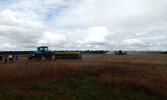Learning from Brazil: One of Canada’s leading agricultural competitors
1. Entrepreneurial Risk Taking
The AME Alumni Class visited Brazil from February 4 – 16, 2014.
This is the first article in a series of three based on lessons learned.
In several of our daily commentaries we pointed out some of the extraordinary changes that have taken place in Brazil over the past 60 years. Paraná is a state that has a number of cities of 70,000 to well over half a million that didn’t exist 60 years ago. The first stage of expansion took place with farmers from the south coming into Paraná and clearing land to produce agricultural products. The second stage occurred in the 1970s and 80s when farmers from Paraná and the areas farther to the south, as well as some immigrants, moved into the Cerrado region of Mato Grosso and did it all over again! A third wave has started now as land is being cleared farther north and east in the Cerrado region.
The models of development for the first two waves were quite different. In the first, farmers are relatively small and cooperatives play a huge role in marketing as well as in acquiring inputs. Roughly 65-70% of the farm production in Paraná is marketed through cooperatives. The second and third ways are being led by relatively large farms and very little of the cooperative element. To some degree, the people who took the risks in both cases are the same people or are their descendants.
What all of the waves have in common is that they were done on land that was virgin, relatively poor red soils, with high acidity and often quite erodible. In all cases, people banded together using mainly private-sector funds (80% of agricultural research is private) to find ways to deal with these environmental problems. As we pointed out, 25 years ago the Iguassu River ran red because of the upstream erosion. The result is the world leader in no-till farming, which along with other cultural practices, has stopped runoff is adding organic matter to the cup to soils, has facilitated second and third crops. In addition, we saw terraces and a number of other environmental practices designed to conserve soil. And soybean yields are consistently around 60 bushels per acre.
The big breakthrough that is given credit for much of the region’s success is the no-till practices that came in late 1980s and early 1990s, after which the real expansion has taken place in agricultural production. Acreage expanded by about 45% since 1991, while production increased by approximately 230%.
Every expansion and technological improvement has been done by entrepreneurs who were willing to take the risks, both with the expansion of acreage as well as new technologies to overcome the weaknesses that were inherent in Brazilian production. There are some extremely successful and wealthy people in Brazil, largely because they were willing to take some risks and be dictated together through cooperatives or on their own despite government policies that are somewhat less than encouraging, as we will discuss in a further commentary.
NEXT: Corporate Social Responsibility
Agri-Food Management Excellence (AME) is a Canadian-based company that provides premiere management and leadership training for agri-food professionals. It was founded by Heather Broughton and Larry Martin who are professionals in their fields. More significantly, they are passionate about helping others to transform their business and life by focusing on what is important. They are supported by a set of well-respected instructors from academia and industry. Through expert, practical application and the development of strong relationships with peers and instructors, people who complete AME training programs genuinely aspire for more and have the confidence to achieve their goals. Courses include the well-respected CTEAM, CFAME and Price Risk Management using Futures and Options.
www.agrifoodtraining.com








